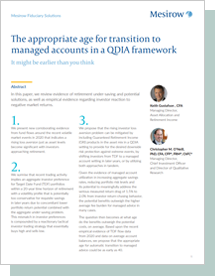The appropriate age for transition to managed accounts in a QDIA framework
Share this article
by Keith Gustafson, CFA and Christopher M. O'Neill, PhD, CFA, CFP®, FRM®, ChFC®
Abstract
In this paper, we review evidence of retirement under-saving and potential solutions, as well as empirical evidence regarding investor reaction to negative market returns.
We present new corroborating evidence from fund flows around the recent volatile market events in 2020 that indicates a rising loss aversion just as asset levels become significant with investors approaching retirement.
We surmise that recent trading activity implies an aggregate investor preference for Target Date Fund (TDF) portfolios within a 20-year time horizon of retirement with a volatility profile that is potentially too conservative for requisite savings in later years due to concomitant lower portfolio return potential combined with the aggregate under-saving problem. This mismatch in investor preferences is compounded by a reactionary tactical investor trading strategy that essentially buys high and sells low.
We propose that the rising investor loss aversion problem can be mitigated by including Guaranteed Retirement Income (GRI) products in the asset mix in a QDIA setting to provide for the desired downside risk protection against extreme events, by shifting investors from TDF to a managed account setting in later years, or by utilizing both approaches in tandem. Given the evidence of managed account utilization in increasing aggregate savings rates, reducing portfolio risk levels and its potential to meaningfully address the serious measured return drag of 1.5% to 2.0% from investor return-chasing behavior, the potential benefits outweigh the higher average fee burden for managed advice in many cases. The question then becomes at what age do the benefits outweigh the potential costs, on average. Based upon the recent empirical evidence of TDF flow data from 2020 and data on average account balances, we propose that the appropriate age for automatic transition to managed advice could be as early as 40.
Neither principal nor the underlying assets of target date investments are guaranteed at any time, including the target date, and investment risk remains at all time. There is no assurance that the recommended asset allocation will either maximize returns or minimize risk or be the appropriate allocation in all circumstances for every investor with a particular time horizon. As described in this guide, each GRI product has its own unique features. The amount that may be paid under a GRI product may be impacted by a number of different factors including, the GRI’s contract provisions and the claims paying ability of the product’s insurer.
Mesirow refers to Mesirow Financial Holdings, Inc. and its divisions, subsidiaries and affiliates. The Mesirow name and logo are registered service marks of Mesirow Financial Holdings, Inc. ©2025, Mesirow Financial Holdings, Inc. All rights reserved. Any opinions expressed are subject to change without notice. Past performance is not indicative of future results. Advisory Fees are described in Mesirow Financial Investment Management, Inc.’s Form ADV Part 2A. Advisory services offered through Mesirow Financial Investment Management, Inc. an SEC registered investment advisor. Securities offered by Mesirow Financial, Inc. member FINRA and SIPC.

